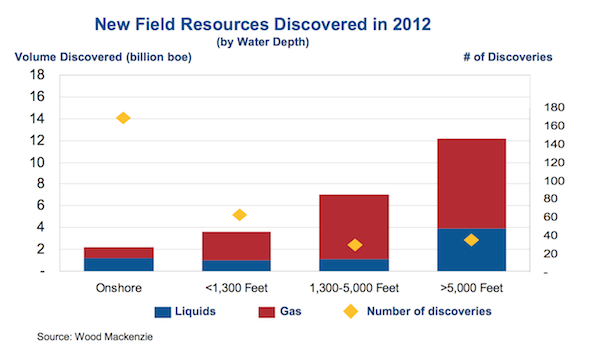The oil business used to be dominated by oil fields found in the Middle East, Texas, and other locations where the material could be easily extracted. But today's oil industry is increasingly looking to shale deposits and offshore drilling for new reserves. Shale drilling may be getting the headlines now, but it's under more than a mile of water where I see huge opportunities in the energy industry.
New reserves offshore
Most of the easy onshore oil has been exploited, which is why the oil industry is searching for oil in deeper water. Economically, this wouldn't have been feasible a decade ago, but with oil hovering near $100 per barrel new drilling methods have become profitable. The newest economical drilling location is in ultra-deepwater, which is considered wells drilled in at least 5,000 feet of water.
These ultra-deepwater fields are still relatively new to the oil industry and that means lots of new discoveries. Below is a slide from a recent Seadrill (SDRL +0.00%) presentation that shows ultra-deepwater and deepwater drilling are the only areas where new discoveries are replacing annual depletions.

It's put another way in a Transocean (RIG +0.26%) presentation, with data from Wood Mackenzie, which shows that more than 12 billion barrels of oil equivalent were discovered in more than 5,000 feet of water last year, almost as much as all other areas of the world combined.

Source: Transocean Investors Day presentation with data from Wood Mackenzie.
If most of the new oil and natural gas discoveries around the world are being made in ultra-deepwater it would make sense that demand for ultra-deepwater drilling rigs are at a premium. That's exactly what we're seeing right now.
The explosion of ultra-deepwater drilling demand
Ultra-deepwater drilling has acted like a reinforcing loop for the industry. The more drilling takes place the more oil is found, which leads to more drilling and more oil discoveries. That's resulted in extremely high rates for ultra-deepwater rigs, as well as growing demand.
Transocean predicts that the global offshore floater fleet will have to increase from 298 units this year to 500 long term. With 160 floaters over 30 years old there's potential for 215 new rigs beyond what's already in the pipeline.
Transocean is taking advantage of this market with 27 ultra-deepwater rigs and another seven under construction. It also has 12 deepwater rigs. Management expects dayrates to remain between $550,00 and $600,00 for newer rigs.
Seadrill has 16 ultra-deepwater rigs, with another eight drillships and four semisubmersibles under construction. This is the most leveraged play on ultra-deepwater drilling and has an incredibly high 8% dividend yield.
Ensco (ESV +0.00%) is another big player, with 29 floaters accounting for 64% of the company's revenue. Another three drillships are under construction, which will add to the fleet.
The final company to look at in offshore drilling is Noble (NE +0.00%), which has 14 drillships and three under construction. It has an older fleet than Seadrill or Ensco, at an average of 9.5 years, but Noble will grow as demand for ultra-deepwater rigs increases.
I think these are the four companies with the best exposure to deepwater drilling and often use each other as a basis for comparison.
Deep opportunities
Oil discoveries that are moving further offshore provide a great opportunity for investors buying ultra-deepwater drilling rig owners. Of the list above, I think Transocean and Seadrill present the best opportunities because of their weighted exposure toward this market. That said, Noble and Ensco provide a more diverse approach to drilling for investors who don't want to take the risk on a leveraged ultra-deepwater play.
Long term, I think the entire group will outperform the market and provide great dividend opportunities for investors. This is a top area to invest in energy.